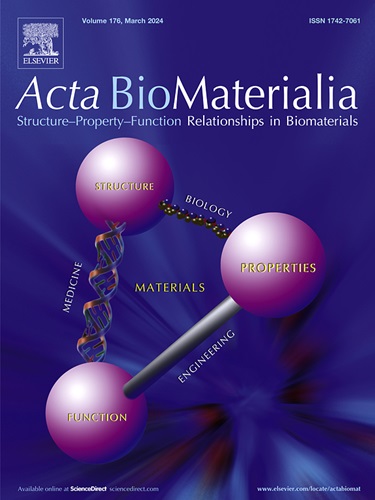Oxygen/siRNA-carrying fluoro-nanosensitizers for radio-immunotherapy sensitization
IF 9.4
1区 医学
Q1 ENGINEERING, BIOMEDICAL
引用次数: 0
Abstract
The anti-tumor efficacy of radiotherapy (RT) is limited by the hypoxic and immunosuppressive tumor microenvironment (TME), which leads to RT resistance and failure in eradicating distant metastatic lesions. Herein, we developed a fluorinated nanosensitizer that could deliver both oxygen (O2) and ADAR1 siRNA into tumor cells to reinforce RT by alleviating hypoxia and immunosuppression. Fluorinated poly(β-amino ester) (fPBAE) was designed to complex ADAR1 siRNA (siADAR1) via electrostatic attraction and load O2 due to the O2-dissolving capacity of fluoroalkyls. The formed nanocomplexes (NCs) facilitated robust cytosolic delivery into cancer cells after intratumoral injection, enabling efficient ADAR1 silencing to promote IFN-β release and enhance DC maturation and T cell infiltration. At the meantime, O2 was released to alleviate tumoral hypoxia. As thus, NCs significantly enhanced the anti-tumor efficacy of RT and when further coupled with programmed death ligand-1 antibody, they effectively restrained the growth of both treated primary tumors and untreated distant tumors by eliciting robust systemic immune response. This study therefore reports an enlightened strategy for remodeling the immunosuppressive TME and sensitizing radio-immunotherapy.
Statement of significance
The hypoxic and immunosuppressive tumor microenvironment (TME) greatly limits the anti-tumor efficacy of radiotherapy (RT). To address this critical issue, a nano-sensitizer based on fluorinated poly(β-amino ester) (fPBAE) is herein developed to mediate efficient co-delivery of oxygen (O₂) and ADAR1 siRNA into tumor cells. ADAR1 silencing promotes DC maturation and T cell infiltration to reverse immunosuppression while the released O₂ alleviates hypoxia to sensitize RT. Thus, the nano-sensitizer remarkably enhances the anti-tumor efficacy of RT and elicits robust systemic immune response to eradicate primary and distant tumors when further coupled with PD-L1 antibody. This study provides a promising approach for RT sensitization and radio-immunotherapy.

携带氧/ sirna的氟纳米增敏剂用于放射免疫治疗增敏。
放疗(RT)的抗肿瘤效果受到缺氧和免疫抑制肿瘤微环境(TME)的限制,导致放疗抵抗和远处转移灶根除失败。在此,我们开发了一种氟化纳米增敏剂,可以将氧气(O2)和ADAR1 siRNA同时输送到肿瘤细胞中,通过减轻缺氧和免疫抑制来增强RT。利用氟烷基对O2的溶解能力,设计了氟化聚(β-氨基酯)(fPBAE)通过静电吸引络合ADAR1 siRNA (siADAR1),并负载O2。形成的纳米复合物(nc)在瘤内注射后促进了强大的细胞质递送到癌细胞中,使ADAR1有效沉默,促进IFN-β释放,增强DC成熟和T细胞浸润。同时释放O2,缓解肿瘤缺氧。因此,NCs显著增强了RT的抗肿瘤功效,当与程序性死亡配体-1抗体进一步偶联时,它们通过引发强大的全身免疫反应,有效地抑制了治疗过的原发肿瘤和未治疗过的远处肿瘤的生长。因此,本研究报告了一种开明的策略来重塑免疫抑制性TME和增敏放射免疫治疗。意义声明:缺氧和免疫抑制的肿瘤微环境(TME)极大地限制了放疗(RT)的抗肿瘤效果。为了解决这一关键问题,本文开发了一种基于氟化聚β-氨基酯(fPBAE)的纳米增敏剂,以介导氧(O₂)和ADAR1 siRNA有效地共同递送到肿瘤细胞中。ADAR1沉默促进DC成熟和T细胞浸润以逆转免疫抑制,而释放的O₂使RT增敏。因此,纳米增敏剂显著增强RT的抗肿瘤功效,并与PD-L1抗体进一步偶联,引发强大的全身免疫应答,以根除原发性和远处肿瘤。
本文章由计算机程序翻译,如有差异,请以英文原文为准。
求助全文
约1分钟内获得全文
求助全文
来源期刊

Acta Biomaterialia
工程技术-材料科学:生物材料
CiteScore
16.80
自引率
3.10%
发文量
776
审稿时长
30 days
期刊介绍:
Acta Biomaterialia is a monthly peer-reviewed scientific journal published by Elsevier. The journal was established in January 2005. The editor-in-chief is W.R. Wagner (University of Pittsburgh). The journal covers research in biomaterials science, including the interrelationship of biomaterial structure and function from macroscale to nanoscale. Topical coverage includes biomedical and biocompatible materials.
 求助内容:
求助内容: 应助结果提醒方式:
应助结果提醒方式:


